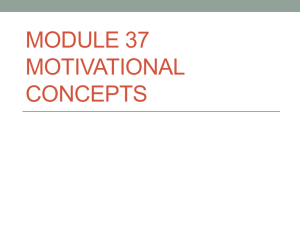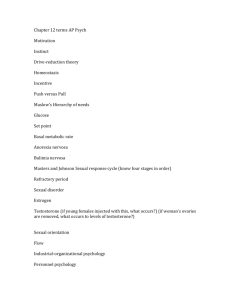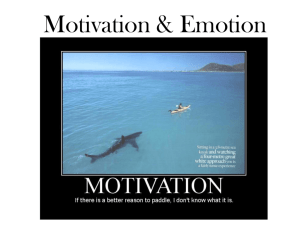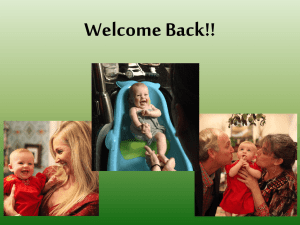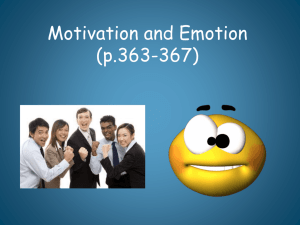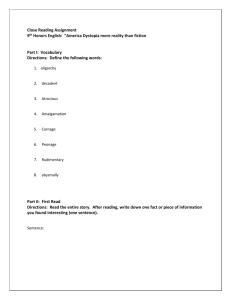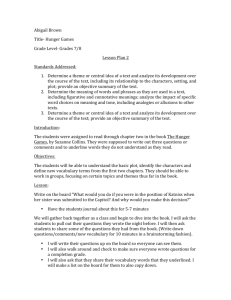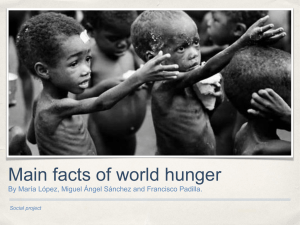Motivation and Emotion
advertisement
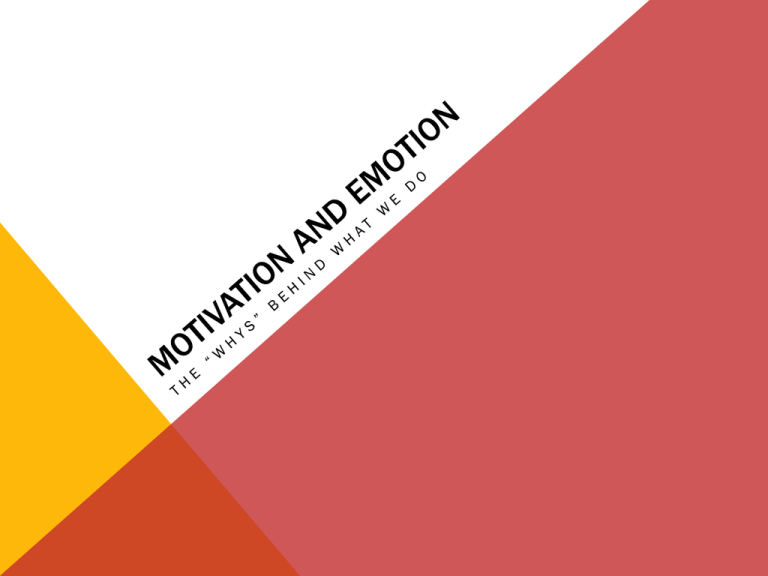
WHAT IS YOUR “PUSH” Motivation - Involves factors that initiate, direct and sustain goal-directed behavior - Motives – what drives behavior and accounts for why we do what we do Biological Sources of Motivation: Evolutionary Theory - Involves inborn needs (such as food, water, oxygen) - Needs are predominantly those necessary for survival Instincts: behaviors programmed by nature - Instinctive behaviors - Fixed, inborn patterns of response Biological needs demand satisfaction -Need – State of deprivation or deficiency (usually biological) -Drive – bodily tension or unease arising from an unmet need (hunger, thirst) -Drive Reduction – satisfaction of a drive Homeostasis -Basis for drive theory -Idea is body tends to maintain a steady internal state AROUSAL THEORY: HARRY HARLOW - Not all drives are to satisfy biological needs - Human (and other animals) may have innate needs for exploration & activity - Stimulus motives – needs to investigate environment and to manipulate it - Notion that there is an optimal level of arousal - This level can vary from individual, and from time to time - Sensation –seekers – high need for arousal - Moderate level of arousal best for most tasks - More difficult tasks – lower levels of arousal needed Why are we not perfect at a new task? Why are we sloppy in our efforts when we are bored? How does stress influence our abilities? We are not idle even when homeostasis level is perfect -Incentive theory – attraction to particular goals or objects motivates much of our behavior ( a drive is a “push” an incentive is a “pull”) -Incentives – rewards or other stimuli which motivate us to act -Incentive values -The strength of the pull an object has ___(Term #1)____ : strict punitive style of parenting (The Science of Psychology, King, Laura, 2011) : impose rules and expect obedience (Psychology, Ninth Edition in Modules, Myers, David G., 2010) : rigid and overcontrolling; expect and demand unquestioned obedience (Psychology Concepts and Application, Nevid, Jeffery S., 2010) ___(Term #2)____ : the extent to which a test measures what it is intended to measure (The Science of Psychology, King, Laura, 2011) : the extent to which a test measures or predicts what it is supposed to (Psychology, Ninth Edition in Modules, Myers, David G., 2010) : the degree to which a test measures what it purports to measure (Psychology Concepts and Application, Nevid, Jeffery S., 2010) EXIT TICKET MARCH 3, 2014 OTHER ELEMENTS OF MOTIVATION Cognitive dissonance – when thoughts and behaviors are incongruent, a state of tension: You do one thing but think another Effort justification – we like objective more if we had to work harder for it - Need for affiliation – need to be socially involved with others - Need to achieve - Sources of motivation - Extrinsic – desire is for external rewards (money, praise) - Intrinsic – effort is given just for personal satisfaction or pleasure -Performance goals – achieving goal for extrinsic reasons -Learning goals – satisfaction is in improving one’s own knowledge or skills EATING DISORDERS THE REALITY OF THOSE WHO CANNOT ALWAYS CLEARLY SEE REALITY… BIOLOGY OF HUNGER - Set Point Theory (body is programmed for ideal weight) - Environmental Factors (Media, life style choices ect…) - Emotional factors (how food makes you feel) - Stats - 60% of adults are overweight - Of those, 26% of adults are obese EATING DISORDERS THE REALITY OF THOSE WHO CANNOT ALWAYS CLEARLY SEE REALITY… BIOLOGY OF HUNGER What Makes Us Hungry? Stomach contractions correspond to hunger pangs (Cannon and Washburn) Individuals with stomach removed still experience hunger and also eat…so WHY? Hypothalamus regulates hunger - Lateral hypothalamus involved in “turning on” hunger - - Ventromedial hypothalamus is the hunger “off-switch” - Neuropeptide Y (chemical released by your brain) stimulates hunger, the hypothalamus, and consumption of carbohydrates - Leptin decreases hunger, reduces production of neuropeptide Y EATING DISORDERS THE REALITY OF THOSE WHO CANNOT ALWAYS CLEARLY SEE REALITY… PERCEPTION OF HUNGER…AND BODY IMAGE Anorexia Nervosa - Intense fear of becoming fat and have a distorted body image - Serious medical complications - Hair growth on body increased - Bodily systems shut down…death - Death rate 5-8% over 10 year time period Bulimia Nervosa - Episodes of binge eating followed by purging - Serious medical complications - Rotting teeth - Burning holes in esophagus (stomach acid more damaging than battery acid) - Death Maslow’s Hierarchy of Needs What happens to the levels above, do you think, if your safety is violated? At your age, which level do you think most struggle with? At your age which level do you think most are at? SelfActualization Esteem Achievement, respect, approval Love and Belongingness Safety Safe and secure housing, protection Physiological Hunger, thirst, avoidance of pain, sexual gratification What are Emotions -Physiological: Bodily arousal – nervous system -Cognitive: Subjective experience and evaluation (how you feel) -Behavioral: What happens outwardly, facial expressions and body language -Theories of Emotions: “Which comes first the Thought or the Feeling?” - James-Lange theory: body reacts first and then emotions are experienced -Cannon-Bard theory: bodily reactions and emotions happen simultaneously -Schater and Singer Two-factor model -We experience the stimulus and then label the emotion evoked Love is both a motive and emotion Commitment Romantic love has a triangular model (Sternberg) Intimacy – close attachment and sharing Passion – strong sexual desire Decision/commitment – awareness of love for the other person and desires to preserve the relationship Different combinations create different types of love -Romantic love: intimacy and passion -Consummate love: intimacy, passion and decision/commitment Passion -Companionate love: intimacy and decision/commitment Intimacy

